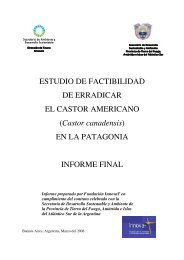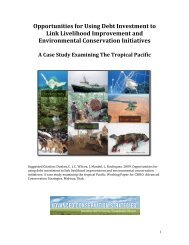Isabela eps:Layout 1 - Advanced Conservation Strategies
Isabela eps:Layout 1 - Advanced Conservation Strategies
Isabela eps:Layout 1 - Advanced Conservation Strategies
Create successful ePaper yourself
Turn your PDF publications into a flip-book with our unique Google optimized e-Paper software.
FERAL GOATS<br />
IN GALAPAGOS<br />
10<br />
Capra hircus in Galapagos<br />
“Nearly half of all terrestrial life forms in Galapagos<br />
are found nowhere else on earth”<br />
Introduced mammals are major drivers of extinction. Feral goats (Capra hircus) are particularly devastating to island<br />
ecosystems, causing direct and indirect impacts through overgrazing, which often results in ecosystem degradation and<br />
biodiversity loss. Goats and donkeys are the primary threat to Galapagos’ most endangered plants, and are believed<br />
responsible for one plant extinction, an endemic from Santiago. Goats convert forest to grassland by stopping regeneration<br />
and felling trees or girdling and killing them with their horns. In this way they eliminate entire forests and ecosystems from<br />
islands they inhabit. Endemic birds, reptiles and other animals that rely on this habitat disappear; if these species are<br />
restricted to those areas they are lost forever. As seen on Santiago, many palatable endemic plant species are often reduced to<br />
individuals hanging on in inaccessible bluffs. Exclosures provide seed banks for safe keeping of these severely reduced<br />
populations, but the threats must be removed for recovery to<br />
occur.<br />
Goat menace!<br />
Removing goat populations from islands is a powerful conservation tool to prevent extinctions and restore ecosystems. Goats<br />
have been eradicated successfully from 120 islands worldwide. With newly developed technology and techniques, island<br />
size is perhaps no longer a limiting factor in the successful removal of introduced goat populations. Furthermore, the use of<br />
global positioning systems (GPS), geographic information systems, aerial hunting by helicopter, specialized hunting dogs, and<br />
Judas goats have dramatically increased efficiency and significantly reduced the duration of eradication campaigns.<br />
Intensive monitoring programs are also critical for successful eradications. Eradication removes the entire population of a<br />
given species from an area, compared to control efforts where a percentage of the population will be removed in perpetuity.<br />
Eradication offers a permanent solution with a once-off investment, and given the clear biodiversity benefits, the introduced<br />
goat populations should be permanently removed.<br />
Because of the presence of humans with domestic goat populations on large islands, future island conservation actions will<br />
require eradication programs that involve local island inhabitants in a collaborative approach with biologists, sociologists,<br />
and educators.<br />
FACT BOX<br />
• Worldwide # of islands where goats have been eradicated: 120<br />
• Range size of these islands: 1 to 132,000 ha<br />
• Cumulated area of these islands: 600,000 ha<br />
• Luxembourg = 50% of PI targeted islands<br />
• Monaco = 0,04 % of PI targeted islands<br />
• PI targeted islands = 20% of Massachusetts State<br />
C. Azul<br />
1,625 m.<br />
TOPOGRAFIC PROFIL<br />
Topographic profile of <strong>Isabela</strong> Island<br />
S. Negra<br />
1,100 m.<br />
PI targeted islands<br />
Pushing the limits to a total new scale<br />
Alcedo<br />
1,150 m.<br />
Darwin<br />
1,425 m.<br />
Wolf<br />
1,707 m.<br />
Ecuador<br />
875 m.<br />
FERAL GOATS<br />
IN GALAPAGOS<br />
11





